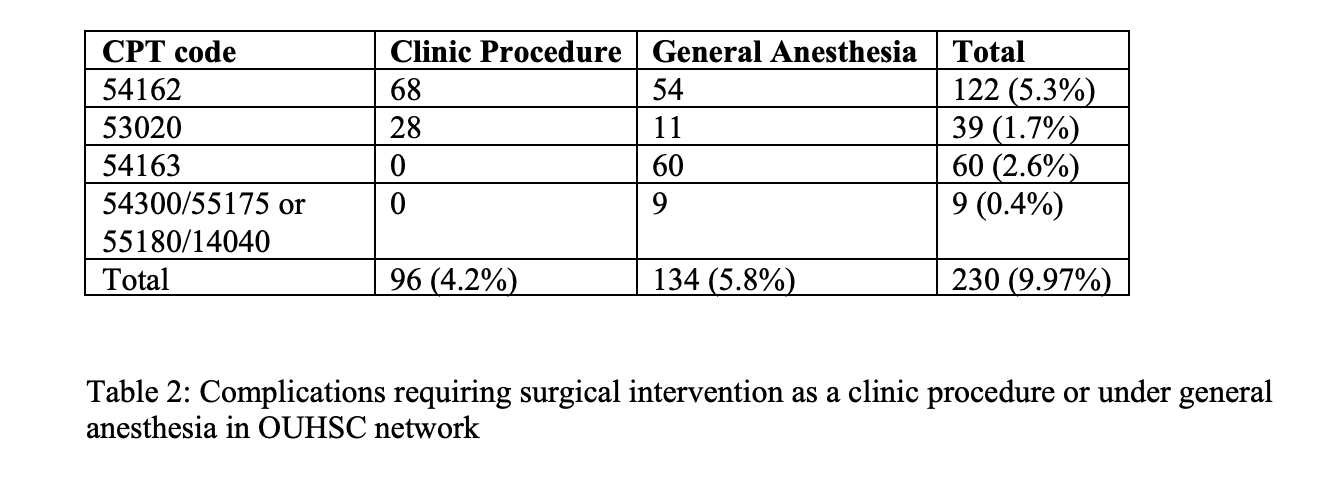Back
Poster, Podium & Video Sessions
Podium
PD48: Pediatic Urology: Genitalia, Upper & Lower Urinary Tract
PD48-12: Newborn Circumcisions by Non-Urologist: Circumcision Complications Requiring Surgical Revision
Sunday, May 15, 2022
2:50 PM – 3:00 PM
Location: Room 244
Abdul Qadar*, Michael Anderson, Oklahoma City , OK, Oren Miller, Tulsa, OK, Bahar Iranpour Broujeni, Adam Rensing, Bhalajee Meenakshi Sundaram, Dominic Frimberger, Oklahoma City , OK
- AQ
Podium Presenter(s)
Introduction: Circumcisions are performed by many health care providers (HCP) other than pediatric urologists (PU). In the hospital setting, families are often unaware who performed the newborn circumcisions and are told to follow-up with a PU if complications arise. The lack of follow-up prevents the performing practitioner from knowing if problems occurred and could be a reason studies underreport the complication rate of circumcisions. The current study reports complication rates of newborn circumcisions performed by HCP other than PU in the state of Oklahoma in a two-year period which required surgical revision.
Methods: Data from two sources were analyzed. The Health Care Authority of Oklahoma (HCAO) provided data on Oklahoman patients covered by Medicaid. The University of Oklahoma Health Sciences Center (OUHSC) delivered data on patients in the OUHSC network. CPT codes were used to identify patients who had a circumcision or circumcision complication in Oklahoma during 2016 and 2017.
Results: In the two-year period, HCAO documented 24,029 circumcisions by HCP other than PU of which 714 required a surgical revision for a complication rate of 2.98%.
In the OUHSC network, 690 circumcisions were performed by Family Medicine, 183 by OB/Gyn and 1435 by Peds for a total of 2308 circumcisions. 230 required a surgical revision for a complication rate of 9.97%. 134 complications required general anesthesia to treat and 96 were treated in clinic.
In the study period, 1730 patients were seen in the PU clinic due to foreskin issues.
Table 1: Number of complications requiring surgical revision for patients covered by Medicaid
Table 2: Complications requiring surgical intervention as a clinic procedure or under general anesthesia in OUHSC network
Conclusions: After newborn circumcisions, concerns by families are very common. This is reflected by the high consultation volume for foreskin issues in PU practices. Most concerns do not require intervention but in the current data up to 9.97% of patients required a surgical intervention for a post circumcision complication.
Source of Funding: None


Methods: Data from two sources were analyzed. The Health Care Authority of Oklahoma (HCAO) provided data on Oklahoman patients covered by Medicaid. The University of Oklahoma Health Sciences Center (OUHSC) delivered data on patients in the OUHSC network. CPT codes were used to identify patients who had a circumcision or circumcision complication in Oklahoma during 2016 and 2017.
Results: In the two-year period, HCAO documented 24,029 circumcisions by HCP other than PU of which 714 required a surgical revision for a complication rate of 2.98%.
In the OUHSC network, 690 circumcisions were performed by Family Medicine, 183 by OB/Gyn and 1435 by Peds for a total of 2308 circumcisions. 230 required a surgical revision for a complication rate of 9.97%. 134 complications required general anesthesia to treat and 96 were treated in clinic.
In the study period, 1730 patients were seen in the PU clinic due to foreskin issues.
Table 1: Number of complications requiring surgical revision for patients covered by Medicaid
Table 2: Complications requiring surgical intervention as a clinic procedure or under general anesthesia in OUHSC network
Conclusions: After newborn circumcisions, concerns by families are very common. This is reflected by the high consultation volume for foreskin issues in PU practices. Most concerns do not require intervention but in the current data up to 9.97% of patients required a surgical intervention for a post circumcision complication.
Source of Funding: None



.jpg)
.jpg)